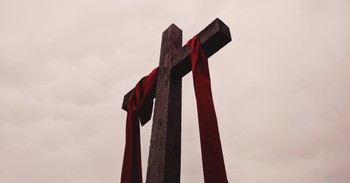
The crowd that gathered in Merton on this day, May 3, 1117 was jubilant. Not only was this the day for celebrating Christ's ascension, but their new religious house, Merton Priory, was being consecrated.
Everyone watched as fifteen Augustinian brothers entered their new home, chanting a Latin hymn: "Salve, festa dies, toto venerabilis aevo, Qua Deus infernum vicit, et astra tenet..." (roughly translated, this is "Hail, joyous day, forever sacred, in which God exchanged the earth for immortality").
Among those joining in the celebration was Gilbert the Norman, Sheriff of Surrey, godson of Queen Matilda in 1114. King Henry I of England had given him lands around Merton a few years before. Gilbert quickly obtained the king's permission to found a monastery. Men arrived to prepare a site near the River Wandle for the religious house. Now, two years and five months later, his dream was a reality.
"And there, during many years," wrote a chronicler, "many persons both noble and gentle, casting aside the world and the old man, very devoutly put on the new man created in justice and sanctity of life."
The history of the priory and the history of the nation bumped against each other again and again in the following years. Its brethren erected a great stone church and buildings large enough to host national conventions. Consequently the kings of England found the place convenient for state purposes. For instance, a century to the year after its founding, the priory became the site of a peace conference with France. It was also at Merton that Henry III met with his barons in 1236 to agree on the Statute of Merton, a basis for English common law. Later Henry VI was crowned here.
Just three years after its founding, Nicholas Breakspeare entered Merton. History remembers him as the only Englishman who became pope--Adrian IV. Another famous scholar who trained at Merton was Thomas a Becket. Elected Archbishop of Canterbury in 1162, he clashed with King Henry II whose knights assassinated the stubborn man.
Almost from the start, the priory founded other monasteries. By 1253 there were ten of these. Merton also exerted a strong influence on Oxford University. Walter de Merton, a prominent clergyman of the thirteenth century, held estates near Merton. He set up a foundation to support scholars at Malden. A few years later, the scholars were transferred to Oxford, and Merton College was founded. The priory administered the foundation and Walter's rule became the norm for English college life.
But the prominence of Merton was not to last. During the Reformation, King Henry VIII ordered the monasteries of England dissolved. The crown confiscated their wealth. In April 1538, Merton Priory surrendered to the King's men. Within the week, workmen began demolition of the four-hundred year old site.
Another four hundred years passed before Col. H. R. Bidder traced the layout of the original buildings. He erected a stone at the site of the priory's high altar. Friends of Merton now hold annual services at Merton.
Bibliography:
- Friends of Merton suggested this story and provided several of its details in e-mail contact with the author.
- Heales, Alfred. Records of Merton Priory Surrey. London: Henry Frowde, 1898.


